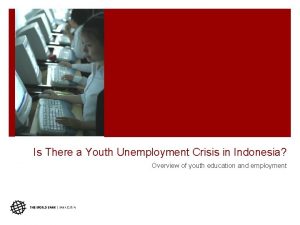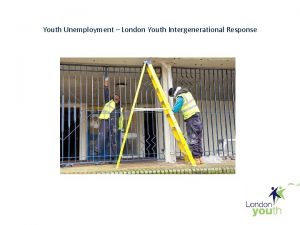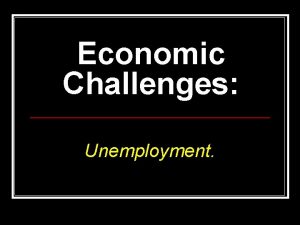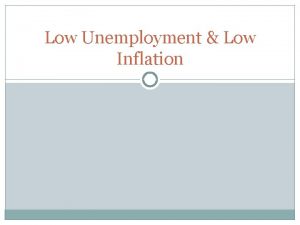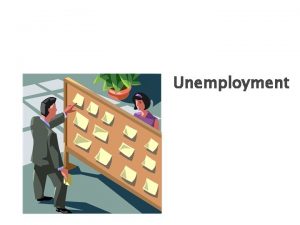Is There a Youth Unemployment Crisis in Indonesia














- Slides: 14

Is There a Youth Unemployment Crisis in Indonesia? Overview of youth education and employment

Levels of youth unemployment in Indonesia are high compared to our neighbors ¡ As of August 2010, 18 percent of young workers are unemployed and looking for a job, compared to only 3 percent for adults; 6 times higher compared to world average of 2. 5 times higher. Composition of youth activities Housekeeping 12. 2% Others 5. 2% Youth unemployment rate (% of labor force ages 15 -24) 50 9 46. 9 8 40 Working 38. 6% 7 6 30 5 25. 1 Student 33. 5% 4 21. 7 20 3 18. 7 14. 9 10 Future job. Discouraged Looking 8. 5% 1. 5% arranged 0. 5% Establishing new business 0. 1% Source: Sakernas, Aug 2010 16. 8 10. 9 6. 7 2 1 0 0 Chile Indonesia Malaysia Mexico Philippines Poland South Africa Turkey Youth unemployment rate (percent, left axis) Ratio of youth unemployment rate to adult unemployment rate (right axis) Source: ILO and WDI, 2007 (Indonesia calcualted from core unemployment Susenas 2007)

Over the next decade, Indonesia is in a position to reap a demographic dividend ¡ The window of a falling dependency ratio will only last for another decade. The ratio of dependents to the working population has been declining over the last four decades, but will start rising again during 2020 -25. Indonesia may enjoy a demographic dividend if the right policy choices support the acceleration of job creation.

… but there is a need to expand good work opportunities for young people ¡ “Good” jobs tend to be formal and non-agricultural. ¡ 53 percent of youth in the workforce find jobs in the informal sector. Most of them work as unpaid family workers. ¡ Over two-thirds of all young employed workers are in agriculture, manufacturing and trade. Real Estate & Business; Health & Social; 1. 05 0. 70 Education; 3. 14 Public Administration; 1. 69 Financial Services; 1. 09 Transportation & Communication; 5. 03 Community Services; 7. 70 Agriculture; 30. 02 Hospitality; 4. 18 Trade; 18. 45 Manufacturing; 18. 78 Fisheries; 2. 08 Mining; 1. 35 Construction; 4. 54 Utilities; 0. 19 Source: Sakernas, August 2010

Why are young workers in Indonesia facing difficulties in finding good jobs? Possible explanations: ¡ Job creation is not keeping pace with new entrants to the workforce. ¡ Rigid labor regulations stunt job creation and entrepreneurship, especially for young workers. ¡ Barriers to self-employment: micro-finance, entrepreneurial skills, etc. ¡ Youth prefer to wait for a better job (unemployment as a luxury good). ¡ Youth lacking work-relevant skills, and not finding jobs in their field of study (mismatch). ¡ Youth do not have access to information about the jobs market.

Youth are entering a highly informal labor market with not enough “good jobs” ¡ Job creation is picking up. However, despite sustained economic growth, not enough “good” (formal and nonagricultural) jobs are being created for the expanding workforce. Employment shares by sector (percent) ¡ Disappointing job creation has reinforced a labor structure that is highly informal and agriculturallybased. Distribution of active workforce by employment status

Informality is not always a trap: many youth use it as a stepping stone to a better job ¡ 53 percent of working youth are employed in the informal sector. With higher education levels, they are less likely to be informal employed than adult workers (60 percent). ¡ Informal jobs tend to be traps for adult workers who would earn more if they had a formal job. For youth, however, informal jobs are more likely to be opportunities than traps. Informal Workers Stayed in the informal sector Moved into the formal sector Total 15 -24 25+ Trap 19. 7 43. 6 Preferred outcome 10. 1 33. 6 Stepping stone 39. 9 13. 9 Unlucky 30. 2 8. 8 100. 0 Formal Workers Stayed in the formal sector Moved into the informal sector Total 15 -24 25+ Sub-optimal 31. 1 15. 3 Preferred outcome 40. 3 46. 3 Stepping stone 7. 8 16. 3 Safety net 20. 8 22. 1 100. 0 Source: Bank staff calculations based on IFLS 2000, IFLS 2007.

Improvements in infrastructure and investment regulations essential for accelerating job creation ¡ Indonesia is less competitive than other countries in the ¡ Total investment in infrastructure has not region largely due to an inefficient bureaucracy, returned to pre-crisis levels, but the inadequate infrastructure, and regulations that hamper government now has the fiscal space to investor interest and infrastructure development. expand infrastructure spending. Total investment in infrastructure, by sectors 8 7 Transports Irrigation Energy Telecom WSS 6 % of GDP 5 4 3 2 1 0 1997 Source: Doing Business, 2010 1998 1999 2000 2001 2002 2003 2004 2005 2006 2007 2008 Source: World Bank, 2010

…but tough labor laws shrink opportunities for young workers entering the formal sector ¡ Stiff regulations disadvantage young workers. High de jure severance rates and restrictions on temporary contracts discourage entrepreneurs and stunts creation of “good” jobs. Young people in rigid labor markets are more likely to experience high unemployment Redundancy costs (weeks of salary) ¡ Trapping employers and most workers in a “lose-lose” situation. Low de facto pay (as reported by workers) leaving the majority of employees unprotected, especially young and low-wage workers. Receipt of severance pay, as reported by terminated workers

A skills shortage in the labor market promises high returns for graduates ¡ There is a short-supply of skilled and educated workers in Indonesia. Only one-fifth of workers have finished senior secondary school; only 6 percent have a tertiary degree. 100. 0% Transition between Education Levels, by cohort 90. 0% ¡ Employers, however, are looking for increasingly higher skill levels resulting in high wage premiums for educated workers, particularly for senior secondary and university graduates. Returns to Education 21 -25 80. 0% 31 -35 70. 0% 41 -45 60. 0% 50. 0% 40. 0% 30. 0% 20. 0% Starting Primary Finish Primary Starting JSS Finish JSS Starting SSS Finish SSS Source: World Bank 2010 based on Susenas (2007) Source: World Bank 2010 based on Sakernas, various years

… but higher educated workers have difficulties in finding work and stay unemployed longer Unemployment rates, by education attainment ¡ Unemployment may be a “luxury good” for better-educated youth who can afford to wait for a better job. Dip IV/University Diploma III ¡ The relative odds of staying unemployed (and seeking) rather than working in an informal job is 28 times greater for a university graduate than for a loweducated (SD and below) worker. Diploma I/II Sr secondary (vocational) Sr secondary (general) Jr secondary ¡ The relative odds of getting a formal job rather than an informal job is 14 times greater for a university graduate than for a low-educated worker. Adult core Primary Youth core Primary (incomplete) No school 0. 0 5. 0 10. 0 15. 0 20. 0 25. 0 30. 0 Source: Sakernas, Feb 2009

Finding a job is difficult for youth – they tend to rely on personal connections to find work ¡ There are many ways that young workers and prospective employers can find each other: advertisements, job fairs, university career services, and customized recruitment strategies by firms. Most youth, however, rely on personal connections with family and friends to find a job. 2% 14% How did you get your job? 5% 13% 12% 10% 4% Job fairs Responded to job ads 18% Contacted company Through friends/relatives 67% Youth (ages 15 -24) Contacted by company 55% Adult (ages 25+) Source: IFLS 2007

… and with poor matching mechanisms, many youth find jobs outside their field of study ¡ Tertiary students are increasingly studying in the fields of business and economics, language and arts, and math/computer. ¡ In 2006, approximately 23 percent of recent tertiary graduates were in jobs outside their field of study. Mismatched graduates from business, economics and public administration earn less, but others earn more. Source: Alisjahbana, 2008, using Sakernas

What can be done? Discussing possible policy responses Improve cognitive skills for youth Targeted scholarships Change perceptions on returns to education Actions to improve learning: early childhood education, quality of learning Reduce skills mismatch Improve on-job experience Labor market information Responsiveness of higher education Upgrade skills of young workers Improve quality and autonomy of BLK Accelerating job creation Enabling a pro-jobs environment: infrastructure and business regulations Introduce new approaches to training: demand-side subsidies, links with labor market, coordinate accreditation Negotiating a grand bargain: severance rates and reform, SJSN expansion Supporting entrepreneurship
 Project proposal for unemployed youth
Project proposal for unemployed youth Acetylcholine crisis
Acetylcholine crisis Indonesia unemployment rate
Indonesia unemployment rate Indonesia youth diplomacy
Indonesia youth diplomacy Indonesia tanah air beta pusaka
Indonesia tanah air beta pusaka No, there aren't
No, there aren't Ecological succession
Ecological succession Some- any
Some- any There is there are part of speech
There is there are part of speech There is there are
There is there are There is there are
There is there are There is and there
There is and there Cheese contable o incontable
Cheese contable o incontable There is there are negative form
There is there are negative form There
There


